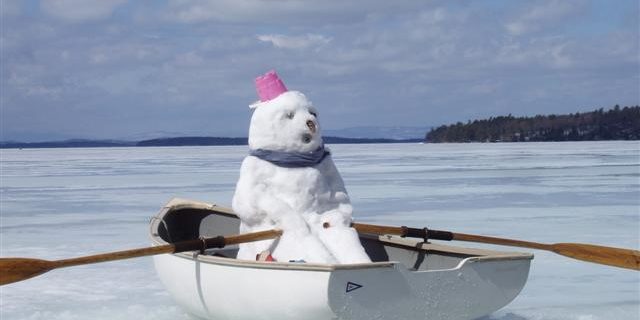Winter boating season has arrived. It’s important to refresh ourselves on some of the precautions and procedures necessary for safe boating under winter conditions. The rule of thumb is if the air and water temperature added together equal less than 100 degrees Fahrenheit you should take special cold temperature precautions:
- Always connect your lanyard or electronic engine safety cut-out switch.
- Have a means of recovering a man overboard quickly (see our post, “Man Overboard! Now What?”.
- Wear a properly fitted life jacket, preferably even a special life jacket with extra insulation.
- Dress for the water temperature, with lots of layers, including a hat. The first layer should be a synthetic fabric that limits water intrusion.
- Bring extra clothes in a dry bag.
- Stock energy bars and a thermos of a warm beverage.
- Know the basics of first aid for treating hypothermia.
Cold Water And Its Effect On The Human Body

Quick recovery is critical, but it is only the beginning of the effort to save a life.
If someone goes into the water, a basic understanding of cold water human physiology can help you save a life. The dangers in cold water immersion are progressive.
First, upon immersion in cold water, the body sustains an immediate gasp reflex. If the head is submerged, the victim will involuntarily inhale water instead of air. Most victims not wearing life jackets will not resurface.
Next, initial cold shock (lasting 3 to 5 seconds) can cause panic, hyperventilation and increase heart rate. In older victims, this shock can cause a heart attack.
Then, within 3 to 30 minutes, the victim will lose the ability to swim, resulting from loss of muscle coordination. This is why the victim must always stay with the boat and never leave a source of flotation. Approximately 75% of victims lose consciousness and die within 3 to 30 minutes of immersion.
Finally, true hypothermia sets in after about 30 minutes. Blood pressure drops, and inhaled water brings lung damage. Heart function is impaired as cold blood from the extremities is released into the body core.
Recovered Victim First Aid
Proper medical attention is essential to re-warm the body of a recovered victim. It is critical to seek trained medical help as fast as possible. In the meantime, trained first aid practices may save the life of the victim.
The victim usually exhibits intense shivering, loss of coordination, mental confusion, cold and blue (cyanotic) skin, weak pulse, uncontrolled breathing, irregular heartbeat and enlarged pupils. During the recovery process, monitor the victim constantly for breathing and a heartbeat. Start CPR if necessary.
The cessation of shivering following recovery brings with it additional danger, because once shivering stops, core body temperature drops rapidly. Wrap the victim in warm clothing to slow loss of core body heat. Gently move the victim to a warm shelter.
Handling the victim with a minimum of body movement is critical–rough handling can cause cardiac arrest or a stroke. Try to keep the victim in the same position as he was rescued. Remove the victim’s wet clothes and replace with dry clothes or a blanket. If possible, warm the clothes first. Cut the wet clothes off if necessary. Ideally, put a stocking cap on the victim’s head. Much heat is lost through the head.
If moving to a warm shelter is necessary, carefully lay the victim in a level, face-up position with a blanket beneath. Only if the person is conscious and coherent, offer warm (not hot) sugary liquids.
Despite what is shown in popular media, never give alcohol to a hypothermic person. This is because alcohol dilates (opens) the veins, which will make the body lose heat more rapidly through the extremities.
Never apply heat to the arms and legs. This forces cold blood from the extremities back toward the heart, lungs and brain, lowering core body temperature and causing “after drop” which can be fatal.
Never massage the victim or give the victim a hot bath—this can cause cardiac arrest.
Even though the victim may appear to be stable, they are still in a cardiovascular crisis. Professional medical treatment must be obtained as quickly as possible.
Reference: https://www.boatus.org/cold-water-boating/hypothermia/







